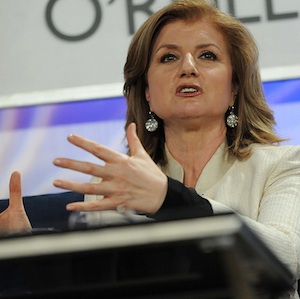 The Huffington Post wants gobs of traffic. It also want reader engagement. But there are some things it just won’t do — like equivocate on whether climate change is real.
The Huffington Post wants gobs of traffic. It also want reader engagement. But there are some things it just won’t do — like equivocate on whether climate change is real.
HuffPost Science recently featured a story on former astronauts and scientists upset with NASA’s position connecting carbon dioxide to climate change. It’s not new to see sides clash on the issue, and any editor knows it’s a debate that will predictably spill over into the comment thread on a story. HuffPost Science senior editor David Freeman offered up this question at the end of his piece: “What do you think? Is NASA pushing ‘unsettled science’ on global warming?”
One problem: The question violated one of the Huffington Post’s editorial policies. Not long after the piece was posted an editor’s note replaced the question, saying in part:
We’ve removed the question because HuffPost is not agnostic on the matter. Along with the overwhelming majority of the scientific community (including 98% of working climate scientists), we recognize that climate change is real and agree with the agencies and experts who are concerned about the role of carbon dioxide.
“The way the call for engagement was raised was as if we’re somehow agnostic about the reality of climate change,” Arianna Huffington told me.
Huffington framed the incident for me as one of editorial policy. But this isn’t a simple case of clashing stylebooks, of one outlet favoring the Oxford comma and another leaving it out. This is something more akin to a policy position: Within the editorial confines of HuffPost, issues like climate change and evolution are settled, Huffington told me. That doesn’t mean divergent viewpoints aren’t welcomed, she said — just that on certain issues the reporting won’t offer up a false equivalency.
“Where truth is ascertainable, we consider it our responsibility to make it very clear and not to — in the guise of some kind of fake objectivity, the media often pretend that every issue has two sides and that both sides deserve equal weight,” Huffington said. “That’s not the case, and that’s not our editorial stand.”
Traditionalists might find the idea of a mainstream, general-audience news organization staking out these kinds of stances in news stories radical. Huffington doesn’t see it that way, saying that traditional media spends far too much time trying to provide balance on issues that are, within certain facts and other data, settled. For her journalists, she said, that means doing reporting that assesses facts and doesn’t “pretend that the truth is supposed to be found in the middle,” she said.
“Editorially, we train our editors and reporters to basically not buy into what Jay Rosen calls the ‘View from Nowhere’ journalism,” she said. “We see our role more as doing everything we can to ferret out the truth, rather than be a kind of Pontius Pilate washing our hand of the possibility of truth.” That’s evocative of NPR’s new ethics guidelines, which make a similar distinction:
In all our stories, especially matters of controversy, we strive to consider the strongest arguments we can find on all sides, seeking to deliver both nuance and clarity. Our goal is not to please those whom we report on or to produce stories that create the appearance of balance, but to seek the truth…If the balance of evidence in a matter of controversy weighs heavily on one side, we acknowledge it in our reports. We strive to give our audience confidence that all sides have been considered and represented fairly.
Along with HuffPost’s internal editorial guidelines, this incident also demonstrates the value of comments and engagement to its brand. (Huffington told me the site had 7 million reader comments last month.) After all, this wasn’t about anything in the body of Freeman’s work — just his call-to-engagement question to readers.
Huffington Post standards editor Adam Rose told me they quickly added the editor’s note on Freeman’s story because they wanted to be transparent with readers about their editorial process. Instead of offering up a reworded question, they wanted to make it clear why the story had been changed. “I think it’s important that our readers know that and can trust that,” he said. “I think by being direct it develops a sense of trust with our readers who understand that we are not equivocating on the issue of climate change.”
The story’s racked up more than 3,300 comments and counting — not an unusual number by HuffPost standards but not an insignificant one either. Rose said he, Freeman, and Huffington were pleased with the quality of the conversation in the comments of the story.
This is where HuffPost’s stance on climate science and other issues has a practical element: The site is placing a marker to let readers know where it stands. Huffington says readers appreciate that kind of honesty and will reward news organizations for it. “Because we are clear about where we believe the truth lies, I believe we elicit a richer kind of response from our readers,” she said. It also helps in moving stories forward. The site already has a follow-up story to Freeman’s piece by reporter Lucia Graves that found that none of the former NASA personnel who signed the climate change letter actually worked in climate science.
Elevating the level of online comments is a fairly decent, if not constantly shifting, goal, but Huffington sees the editorial guidelines as promoting something broader. “To be able to see clearly where truth lies on one side or the other, as it happened in this particular instance, is not to abandon objectivity — it’s to, in fact, embrace a higher standard of journalism,” she said.
Image by JD Lasica used under a Creative Commons license.